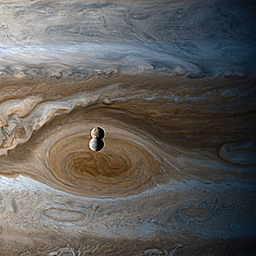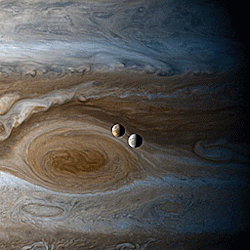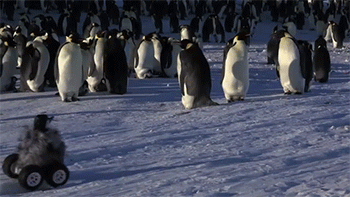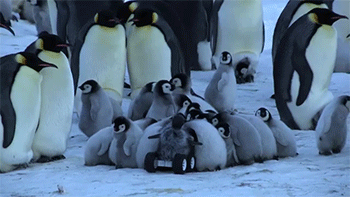Listening To Music Releases Dopamine In The Brain
Listening To Music Releases Dopamine In The Brain
Have you ever been listening to a piece of music and experienced intense pleasure, even chills? Valorie Salimpoor and team (2010) conducted research that shows that listening to music can release the neurotransmitter dopamine.
A wide range of music — The researchers used PET (positron emission tomography) scans, fMRI, and psychophysiological measures such as heart rate to measure reactions while people listened to music. The participants provided music that they said gave them intense pleasure and chills. The range of music varied, from classical, folk, jazz, elecronica, rock pop, tango, and more.
Keep reading
More Posts from Science-is-magical and Others


Timelapse of Europa & Io orbiting Jupiter, shot from Cassini during its flyby of Jupiter

Redrawing the brain’s motor map
Neuroscientists at Emory have refined a map showing which parts of the brain are activated during head rotation, resolving a decades-old puzzle. Their findings may help in the study of movement disorders affecting the head and neck, such as cervical dystonia and head tremor.
The results were published in Journal of Neuroscience.
In landmark experiments published in the 1940s and 50s, Canadian neurosurgeon Wilder Penfield and colleagues determined which parts of the motor cortex controlled the movements of which parts of the body.
Penfield stimulated the brain with electricity in patients undergoing epilepsy surgery, and used the results to draw a “motor homunculus”: a distorted representation of the human body within the brain. Penfield assigned control of the neck muscles to a region between those that control the fingers and face, a finding inconsistent with some studies that came later.
Using modern functional MRI (magnetic resonance imaging), researchers at Emory University School of Medicine have shown that the neck’s motor control region in the brain is actually between the shoulders and trunk, a location that more closely matches the arrangement of the body itself.
“We can’t be that hard on Penfield, because the number of cases where he was able to study head movement was quite limited, and studying head motion as he did, by applying an electrode directly to the brain, creates some challenges,” says lead author Buz Jinnah, MD, professor of neurology, human genetics and pediatrics at Emory University School of Medicine.
The new location for the neck muscles makes more sense, because it corresponds to a similar map Penfield established of the sense of touch (the somatosensory cortex), Jinnah says.
Participants in brain imaging studies need to keep their heads still to provide accurate data, so volunteers were asked to perform isometric muscle contraction. They attempted to rotate their heads to the left or the right, even though head movement was restricted by foam padding and restraining straps.
First author Cecilia Prudente, a graduate student in neuroscience who is now a postdoctoral associate at the University of Minnesota, developed the isometric head movement task and obtained internal funding that allowed the study to proceed.
She and Jinnah knew that isometric exercises for the wrist activated the same regions of the motor cortex as wrist movements, and used that as a reference point in their study. During brain imaging, they were able to check that particular muscles were being tensed by directly monitoring volunteers’ muscles electronically.
When volunteers contracted their neck muscles, researchers were able to detect activation in other parts of the brain too, such as the cerebellum and the basal ganglia, which are known to be involved in movement control. This comes as no surprise, Jinnah says, since these regions also control movements of the hands and other body parts.
Prudente, Jinnah and colleagues have conducted a similar study with cervical dystonia patients, with the goal of comparing the patterns of brain activation between healthy volunteers and the patients. Cervical dystonia is a painful condition in which the neck muscles contract involuntarily and the head posture is distorted.
“These results may help guide future studies in humans and animals, as well as medical or surgical interventions for cervical dystonia and other disorders involving abnormal head movements,” Prudente says.

Possible case for fifth force of nature
A team of physicists at the University of California has uploaded a paper to the arXiv preprint server in which they suggest that work done by a team in Hungary last year might have revealed the existence of a fifth force of nature. Their paper has, quite naturally, caused quite a stir in the physics community as several groups have set a goal of reproducing the experiments conducted by the team at the Hungarian Academy of Science’s Institute for Nuclear Research.
The work done by the Hungarian team, led by Attila Krasznahorkay, examined the possible existence of dark photons - the analog of conventional photons but that work with dark matter. They shot protons at lithium-7 samples creating beryllium-8 nuclei, which, as it decayed, emitted pairs of electrons and positrons. Surprisingly, as they monitored the emitted pairs, instead of a consistent drop-off, there was a slight bump, which the researchers attributed to the creation of an unknown particle with a mass of approximately 17 MeV. The team uploaded their results to the arXiv server, and their paper was later published by Physical Review Letters. It attracted very little attention until the team at UoC uploaded their own paper suggesting that the new particle found by the Hungarian team was not a dark photon, but was instead possibly a protophobic X boson, which they further suggested might carry a super-short force which acts over just the width of an atomic nucleus - which would mean that it is a force that is not one of the four described as the fundamental forces that underlie modern physics.
The paper uploaded by the UoC team has created some excitement, as well as public exclamations of doubt - reports of the possibility of a fifth force of nature have been heard before, but none have panned out. But still, the idea is intriguing enough that several teams have announced plans to repeat the experiments conducted by the Hungarian team, and all eyes will be on the DarkLight experiments at the Jefferson Laboratory, where a team is also looking for evidence of dark photons - they will be shooting electrons at gas targets looking for anything with masses between 10 and 100 MeV, and now more specifically for those in the 17 MeV region. What they find, or don’t, could prove whether an elusive fifth force of nature actually exists, within a year’s time. [Image][Continue Reading→]

Scientists have discovered the world’s oldest known water in an ancient pool in Canada that’s at least 2 billion years old.
Back in 2013 they found water dating back about 1.5 billion years at the Kidd Mine in Ontario, but searching deeper at the site revealed an even older source buried underground.
The initial discovery of the ancient liquid in 2013 came at a depth of around 2.4 kilometres (1.5 miles) in an underground tunnel in the mine. But the extreme depth of the mine – which at 3.1 kilometres (1.9 miles) is the deepest base metal mine in the world – gave researchers the opportunity to keep digging.
“[The 2013 find] really pushed back our understanding of how old flowing water could be and so it really drove us to explore further,” geochemist Barbara Sherwood Lollar from the University of Toronto told Rebecca Morelle at the BBC.
“And we took advantage of the fact that the mine is continuing to explore deeper and deeper into the earth.”
The new source was found at about 3 kilometres (1.9 miles) down, and according to Sherwood Lollar, there’s a lot more of it than you might expect.
Continue Reading.

I am not going to tag the name of the bird, because I’m pretty sure I would get tagged as NSFW if I did, but I assure you their beaks are getting longer and it’s probably because of the UK’s obsession with bird feeders.
Newly discovered windows of brain plasticity may help with treatment of stress-related disorders
Chronic stress can lead to changes in neural circuitry that leave the brain trapped in states of anxiety and depression. But even under repeated stress, brief opportunities for recovery can open up, according to new research at The Rockefeller University.

(Image caption: Routine versus disruptive: A familiar stressor (left) did not increase NMDA receptors (dark spots), a booster of potentially harmful glutamate signaling, in the brains of mice. However, when subjected to an unfamiliar stress (right), mice expressed more NMDA receptors)
“Even after a long period of chronic stress, the brain retains the ability to change and adapt. In experiments with mice, we discovered the mechanism that alters expression of key glutamate-controlling genes to make windows of stress-related neuroplasticity—and potential recovery—possible,” says senior author Bruce McEwen, Alfred E. Mirsky Professor, and head of the Harold and Margaret Milliken Hatch Laboratory of Neuroendocrinology. Glutamate is a chemical signal implicated in stress-related disorders, including depression.
“This sensitive window could provide an opportunity for treatment, when the brain is most responsive to efforts to restore neural circuitry in the affected areas,” he adds.
The team, including McEwen and first author Carla Nasca, wanted to know how a history of stress could alter the brain’s response to further stress. To find out, they accustomed mice to a daily experience they dislike, confinement in a small space for a short period. On the 22nd day, they introduced some of those mice to a new stressor; others received the now-familiar confinement.
Then, the researchers tested both groups for anxiety- or depression-like behaviors. A telling split emerged: Mice tested shortly after the receiving the familiar stressor showed fewer of those behaviors; meanwhile those given the unfamiliar stressor, displayed more. The difference was transitory, however; by 24 hours after the final stressor, the behavioral improvements seen in half of the mice had disappeared.
Molecular analyses revealed a parallel fluctuation in a part of the hippocampus, a brain region involved in the stress response. A key molecule, mGlu2, which tamps down the release of the neurotransmitter glutamate, increased temporarily in mice subjected to the familiar confinement stress. Meanwhile, a molecular glutamate booster, NMDA, increased in other mice that experienced the unfamiliar stressor. In stress-related disorders, excessive glutamate causes harmful structural changes in the brain.
The researchers also identified the molecule regulating the regulator, an enzyme called P300. By adding chemical groups to proteins known as histones, which give support and structure to DNA, P300 increases expression of mGlu2, they found.
In other experiments, they looked at mice genetically engineered to carry a genetic variant associated with development of depression and other stress-related disorders in humans, and present in 33 percent of the population.
“Here again, in experiments relevant to humans, we saw the same window of plasticity, with the same up-then-down fluctuations in mGlu2 and P300 in the hippocampus,” Nasca says. “This result suggests we can take advantage of these windows of plasticity through treatments, including the next generation of drugs, such as acetyl carnitine, that target mGlu2—not to ‘roll back the clock’ but rather to change the trajectory of such brain plasticity toward more positive directions.”
-
 elusiveimp reblogged this · 7 years ago
elusiveimp reblogged this · 7 years ago -
 thelifeofanaveragegirl20 reblogged this · 8 years ago
thelifeofanaveragegirl20 reblogged this · 8 years ago -
 ichbinssam liked this · 8 years ago
ichbinssam liked this · 8 years ago -
 science-is-magical reblogged this · 8 years ago
science-is-magical reblogged this · 8 years ago -
 aquasnewmoonblog reblogged this · 8 years ago
aquasnewmoonblog reblogged this · 8 years ago -
 wild-trxye reblogged this · 8 years ago
wild-trxye reblogged this · 8 years ago -
 whynerdworks-blog reblogged this · 8 years ago
whynerdworks-blog reblogged this · 8 years ago -
 kalooeh reblogged this · 8 years ago
kalooeh reblogged this · 8 years ago -
 clgzb reblogged this · 8 years ago
clgzb reblogged this · 8 years ago -
 kalooeh liked this · 8 years ago
kalooeh liked this · 8 years ago -
 startoverrr reblogged this · 8 years ago
startoverrr reblogged this · 8 years ago -
 sayastoria liked this · 8 years ago
sayastoria liked this · 8 years ago -
 suchgr liked this · 8 years ago
suchgr liked this · 8 years ago -
 purgatory-emporium reblogged this · 8 years ago
purgatory-emporium reblogged this · 8 years ago -
 purgatory-emporium liked this · 8 years ago
purgatory-emporium liked this · 8 years ago -
 deredereforyandere liked this · 8 years ago
deredereforyandere liked this · 8 years ago -
 fruitpunch493 liked this · 8 years ago
fruitpunch493 liked this · 8 years ago -
 tri-yonce reblogged this · 8 years ago
tri-yonce reblogged this · 8 years ago -
 journey-nibs liked this · 8 years ago
journey-nibs liked this · 8 years ago -
 clockworkfall liked this · 8 years ago
clockworkfall liked this · 8 years ago -
 nocontent liked this · 8 years ago
nocontent liked this · 8 years ago -
 6lackwitches reblogged this · 8 years ago
6lackwitches reblogged this · 8 years ago -
 6lackwitches liked this · 8 years ago
6lackwitches liked this · 8 years ago -
 sseraphissm liked this · 8 years ago
sseraphissm liked this · 8 years ago -
 inlovewiththemoonglight liked this · 8 years ago
inlovewiththemoonglight liked this · 8 years ago -
 cigarettes0uls liked this · 8 years ago
cigarettes0uls liked this · 8 years ago -
 odeevibez reblogged this · 8 years ago
odeevibez reblogged this · 8 years ago -
 odeevibez liked this · 8 years ago
odeevibez liked this · 8 years ago -
 spacedoutdaydreamer reblogged this · 8 years ago
spacedoutdaydreamer reblogged this · 8 years ago -
 spacedoutdaydreamer liked this · 8 years ago
spacedoutdaydreamer liked this · 8 years ago -
 night-of-words liked this · 8 years ago
night-of-words liked this · 8 years ago -
 grimmgangler reblogged this · 8 years ago
grimmgangler reblogged this · 8 years ago -
 grimmgangler liked this · 8 years ago
grimmgangler liked this · 8 years ago -
 flarmasaurus-rex reblogged this · 8 years ago
flarmasaurus-rex reblogged this · 8 years ago -
 leenners13 reblogged this · 8 years ago
leenners13 reblogged this · 8 years ago -
 motolummo-blog liked this · 8 years ago
motolummo-blog liked this · 8 years ago -
 staceylii liked this · 8 years ago
staceylii liked this · 8 years ago -
 nataliadlt90 liked this · 8 years ago
nataliadlt90 liked this · 8 years ago -
 lerougerosie liked this · 8 years ago
lerougerosie liked this · 8 years ago -
 minty-chocolatechip liked this · 8 years ago
minty-chocolatechip liked this · 8 years ago
















